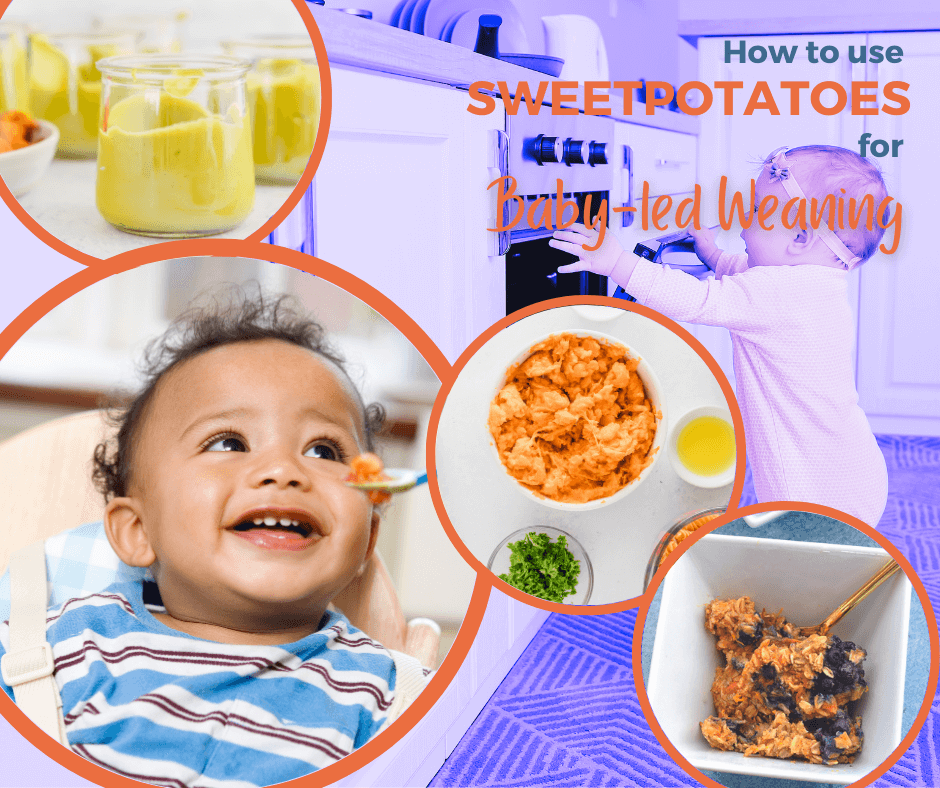How to use sweetpotatoes for baby-led weaning

Feeding babies can be both a source of excitement as well as stress and anxiety. While we all love watching a baby explore food (and the mess that comes with it!), it can be intimidating to know what to feed a baby to avoid choking and ensure adequate nutrition.
Sweetpotatoes are a wonderful “first food” for babies for several reasons. Firstly, sweetpotatoes are soft and mashable, which is important for serving to babies, especially when they don’t have teeth. Secondly, sweetpotatoes are a source of ample nutrition for babies, providing Vitamin A, Vitamin C, potassium, fiber, iron, calcium, and other micronutrients.
The Vitamin C content in sweetpotatoes is a critical helper nutrient in aiding in the absorption of iron. Iron is a crucial nutrient for an infant’s growth and brain development, and serving sweetpotatoes along with iron-rich foods is a wonderful pairing.
Another great quality of sweetpotatoes is their versatility. They can be prepared in several different ways and pair well with nearly every food and food group, including fruits and vegetables, meat, poultry, eggs, whole grains, and beans and legumes. Sweetpotatoes are typically not an allergenic food, so are generally safe to introduce when the baby is ready for solids (but always check with your pediatrician).
While spoon-feeding may be the traditional way of feeding babies, baby-led weaning (BLW) is another option that is gaining traction. Baby-led weaning refers to a method of introducing solid foods into a baby’s diet by allowing them to feed themselves, starting at around six months of age or signs of readiness.
There are several benefits to baby-led weaning, including making feeding easier, allowing children to be more receptive to different flavors and promoting good eating behaviors, especially later in life.
Baby-led weaning enables babies to be active participants in the feeding process, by allowing them to choose what and how much they want to eat. Many proponents of baby-led weaning also claim that it helps to reduce picky eating in the future.
A 2015 study found that babies who were introduced to solids through a BLW approach were more in touch with their hunger and fullness sensations around 18-24 months of age compared to those who used a more traditional, puree-feeding approach.
Baby-led weaning doesn’t have to be all or nothing in terms of spoon-feeding vs. letting babies feed themselves. It can incorporate both methods or whatever the parent(s) is/are comfortable with.
Here are some of the common ways to introduce sweetpotatoes to babies:
– Mashed sweetpotatoes (these can also be mixed with other foods, such as butter, mashed broccoli, beef, eggs or peanut butter)
– Spinach sweetpotato baby food
– Roasted sweetpotato fries that baby can hold
– Mixed into an iron-rich meatball (although leave out BBQ sauce and pecans and limit salt for babies)
– Blended into hummus or a dip
– Mashed into oatmeal
As babies evolve into toddlers, the opportunities remain endless for incorporating nutrient-rich sweetpotatoes into their diets. As kids grow older, many are drawn to sweeter foods, and sweetpotatoes are naturally sweet and free of added sugars.
Sweetpotatoes also offer a stellar option for those with sensory disorders, due to their bright “eye candy” colors, as well as their ability to be molded into several textures, and take on sweet or savory flavors.
Whether you hide them in a baked good, like whole wheat sweetpotato zucchini muffins, or in a mac and cheese dish, or even add them to a beautiful smoothie, sweetpotatoes can add a pop of color to any dish and add more appeal, improve the taste and texture, and provide essential nutrition to growing babies.
Need more inspiration for baby-led weaning recipes? Check out our array of kid-friendly!